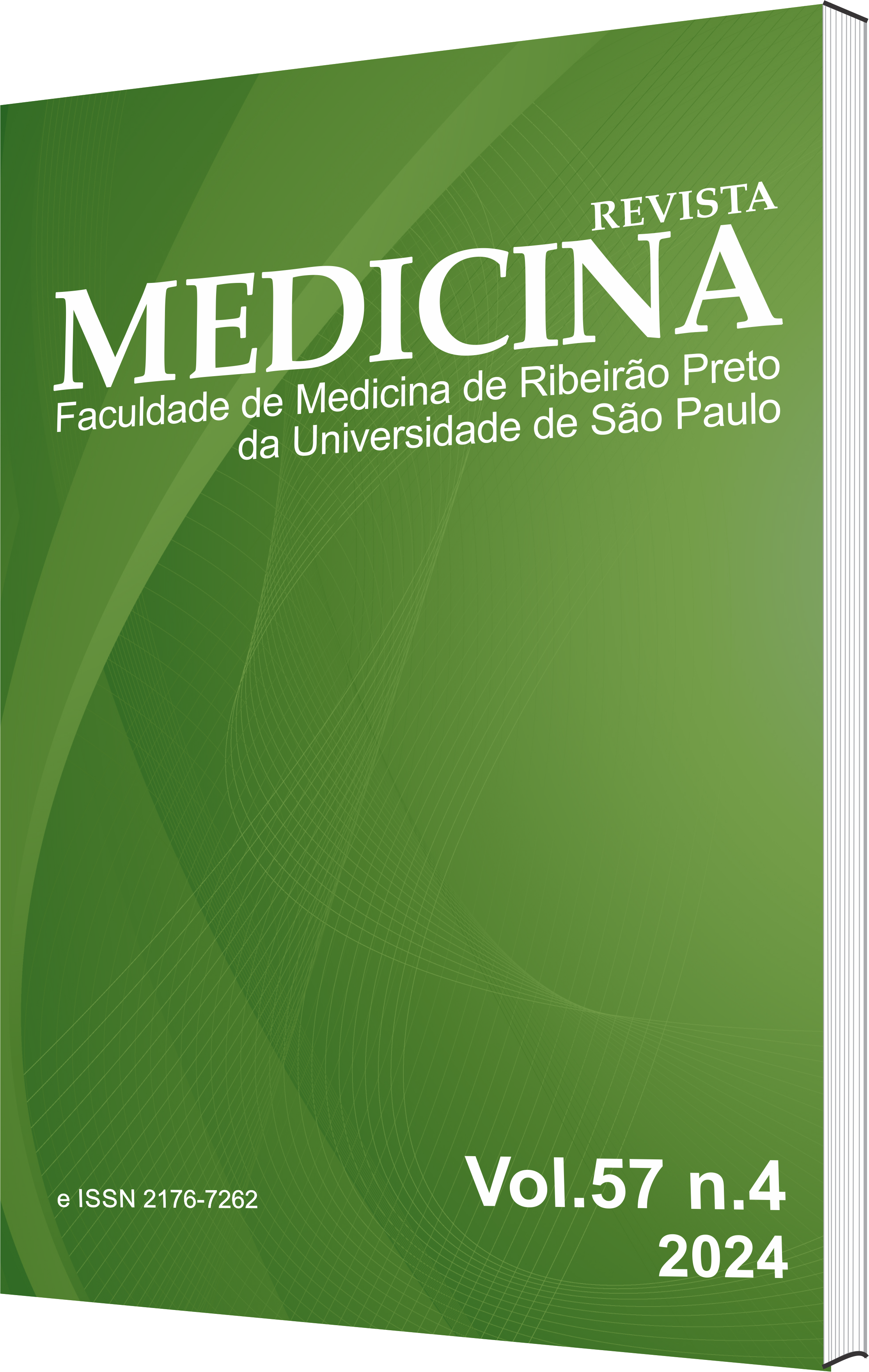Identification of cases of color blindness in the academic community: implications for teaching-learning
DOI:
https://doi.org/10.11606/issn.2176-7262.rmrp.2024.217330Keywords:
Color blindness, Higher education, Ishihara testAbstract
Introduction: Color blindness continues to be a neglected condition in educational environments and there are no data available on the prevalence and characteristics of cases in the academic context. In higher education, there is a lack of data on the limitations imposed by the condition, as well as on the predilection of color-blind individuals for different areas of knowledge. Methods: In this work, a series study of color blindness cases was conducted in the academic community of Barreiras, Bahia, Brazil, where cases were identified using the Ishihara online test associated with symptomatologic interrogation in a single digital questionnaire. Results: The prevalence of color blindness within the study population was 6.38% (15/235) of participants. A greater number of cases were observed among participants who are from the area of health knowledge. Although some people with color blindness reported an impairment in their learning process, the findings indicate that this was not a determining condition for choosing an area of knowledge, but it limits the choice of acting in specific areas. The association of a symptomatologic survey allowed us to identify cases of color blindness not distinguishable by the Ishihara online test and, although considered rare, we identified cases of tritanomaly among study participants. Conclusions: In this way, the data points to the presence of cases of color blindness in the academic community of Barreiras in western of the Bahia and suggests that additional studies should be conducted to draw a broader profile on the consequences of color blindness in the teaching-learning processes in higher education.
Downloads
References
Deeb SS. The molecular basis of variation in human color vision. Clin Genet. 2005;67(5):369-377. doi:10.1111/j.1399-0004.2004.00343.x
Deeb SS. Molecular genetics of colour vision deficiencies. Clin Exp Optom. 2004;87(4-5):224-229. doi:10.1111/j.1444-0938.2004.tb05052.x
Bruni LF, Cruz AAVE. Sentido cromático: tipos de defeitos e testes de avaliação clínica. Arq Bras Oftalmol. 2006;69(5):766-775. doi:10.1590/S0004-27492006000500028
Lee J. Uma ferramenta adaptativa para facilitar a visualização de imagens para pessoas portadoras de daltonismo. In: 2008:435-438.
Casarini FC. O daltonismo: um exemplo de herança ligada ao cromossomo x. Monografia. Universidade Federal do Paraná; 2015. Accessed October 19, 2023. https://acervodigital.ufpr.br/bitstream/handle/1884/42326/R%20-%20E%20-%20FRANCIELE%20CRISTINA%20FANHANI%20CASARIN.pdf?sequence=1&isAllowed=y
Kim H, Ng JS. Prevalence of Color Vision Deficiency in an Adult Population in South Korea. Optom Vis Sci Off Publ Am Acad Optom. 2019;96(11):866-873. doi:10.1097/OPX.0000000000001441
Piccinin MRM, Cunha JF, Almeida HPD, et al. Baixa prevalência de discromatopsia, pela 4a edição do teste pseudoisocromático HRR (Hardy, Rand e Rittler), da população indígena de etnia terena da aldeia lalima na região de Miranda: Mato Grosso do Sul. Arq Bras Oftalmol. 2007;70(2):259-269. doi:10.1590/S0004-27492007000200014
Simunovic MP. Colour vision deficiency. Eye Lond Engl. 2010;24(5):747-755. doi:10.1038/eye.2009.251
Fernandes LC, Urbano LCDV. Eficiência dos testes cromáticos de comparação na discromatopsia hereditária: relato de casos. Arq Bras Oftalmol. 2008;71(4):585-588. doi:10.1590/S0004-27492008000400023
van Staden D, Noor Mahomed F, Govender S, Lengisi L, Singh B, Aboobaker O. Comparing the validity of an online Ishihara colour vision test to the traditional Ishihara handbook in a South African university population. Afr Vis Eye Health. 2018;77(1). https://avehjournal.org/index.php/aveh/article/view/370
Jha R, Gautam Y. Prevalence of Color Blindness in Undergraduates of Kathmandu University. J Nepal Med Assoc.
CFM CF de M. Daltonismo: distúrbio atinge 5% da população mundial. Published 2004. Accessed October 19, 2023. https://portal.cfm.org.br/noticias/daltonismo-disturbio-atinge-5-da-populacao-mundial/#:~:text=Olhar%20para%20o%20sinal%20de,o%20problema%20%C3%A9%20facilmente%20contornado.
Khairoalsindi OA, Almasoudi BM, Bamahfouz AY, Alghamdi AA, Siddiqui MI. Prevalence and Determinants of Color Vision Defects among Preparatory University Students at Makkah, Saudi Arabia. Middle East Afr J Ophthalmol. 2019;26(3):133-137. doi:10.4103/meajo.MEAJO_29_19
Stoianov M, De Oliveira MS, Dos Santos Ribeiro Silva MCL, Ferreira MH, De Oliveira Marques I, Gualtieri M. The impacts of abnormal color vision on people’s life: an integrative review. Qual Life Res. 2019;28(4):855-862. doi:10.1007/s11136-018-2030-1
Teixeira FLF, Magalhães S de A, Leite LM, Castro FM de C, Leite JÁ. Prevalência de discromatopsia congênita em estudantes do noroeste fluminese. In: 2010. https://www.inicepg.univap.br/cd/INIC_2010/anais/trabalhos_saude.html
Faleiros F, Käppler C, Pontes FAR, Silva SS da C, Goes F dos SN de, Cucick CD. Use of virtual questionnaire and dissemination as a data collection strategy in scientific studies. Texto Contexto - Enferm. 2016;25(4):e3880014. doi:10.1590/0104-07072016003880014
Melo DG, Galon JEV, Fontanella BJB. Os “daltônicos” e suas dificuldades: condição negligenciada no Brasil? Physis Rev Saúde Coletiva. 2014;24(4):1229-1253. doi:10.1590/S0103-73312014000400011
Viola Andin Dohvoma EE Stève Robert Ebana Mvogo, Giles Kagmeni, Nathalie Rosine Emini, Mvogo CE. Color vision deficiency among biomedical students: a cross-sectional study. Clin Ophthalmol. 2018;12:1121-1124. doi:10.2147/OPTH.S160110
Souza AS. Estudo Sobre o Conforto Visual Nas Interfaces – Com Ênfase No Daltonismo. Dissertação. PUC SP; 2013. Accessed October 19, 2023. https://tede.pucsp.br/handle/handle/18118
Maestrini HA, Fernandes LC, Oliveira ACM. Distrofias retinianas da infância: análise retrospectiva. Arq Bras Oftalmol. 2004;67(6):867-876. doi:10.1590/S0004-27492004000600005.
Downloads
Published
Issue
Section
License
Copyright (c) 2024 Théo Araújo-Santos, Ítalo Ramon Bessa Holanda

This work is licensed under a Creative Commons Attribution 4.0 International License.







